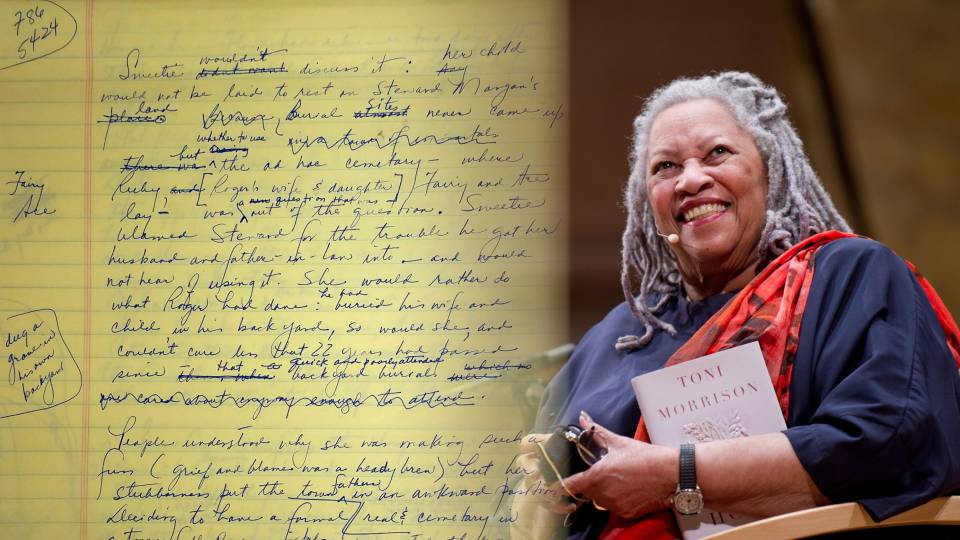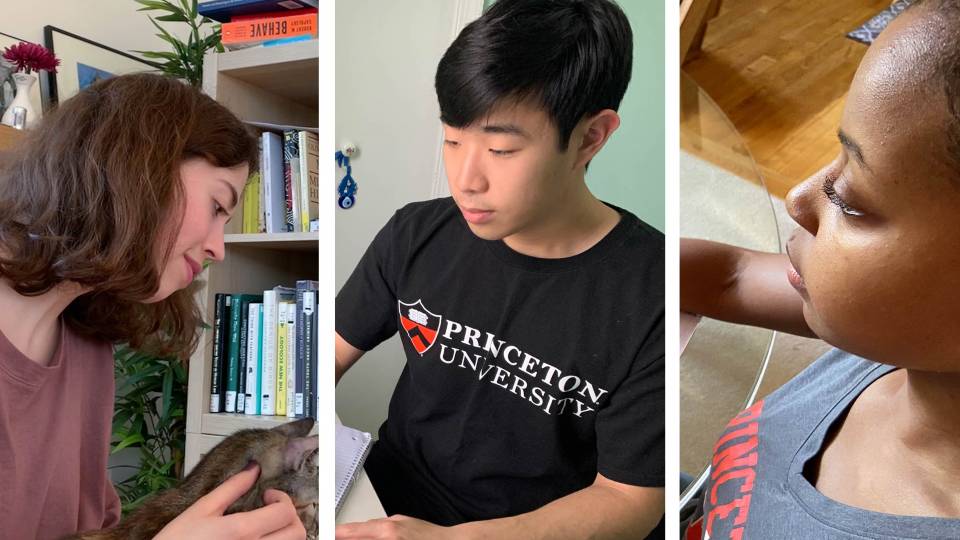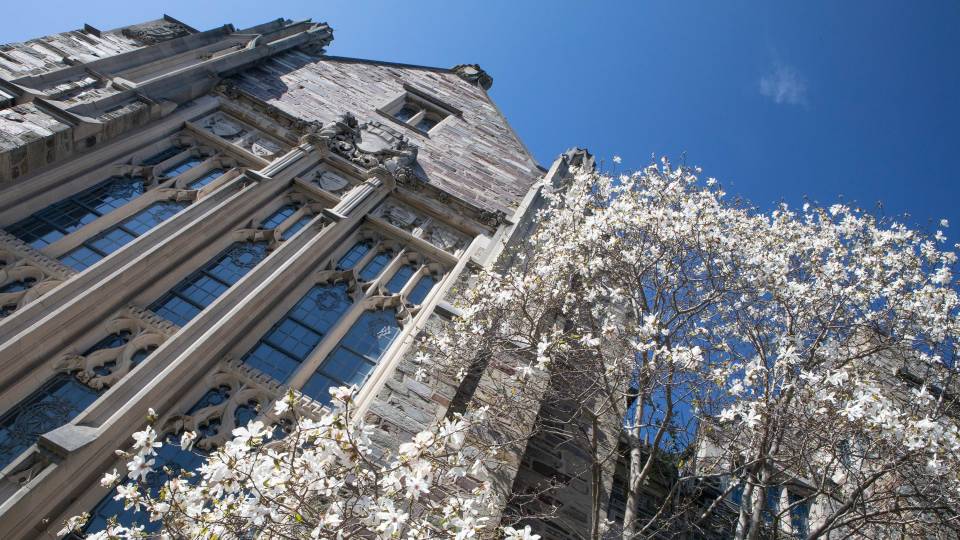In the weeks before Princeton transitioned to remote teaching in March due to the COVID-19 pandemic, students in a range of classes visited the special exhibition “Life Magazine and the Power of Photography” at the Princeton University Art Museum. The exhibition sheds new light on the collaborative process behind the magazine’s iconic photo-essays that captured important moments in history. During the pandemic, students engaged with the exhibition through virtual galleries, online video discussions and lectures by museum staff — all tailored to the academic focus of each course.
In one photo, a young boy, emaciated from hunger, lays on the floor in a favela in Rio de Janeiro. In another, a midwife delivers a baby in the back woods of Appalachia. Other photos capture blurry bodies pushing through the water toward the beach at Normandy and the aftermath of a bloody battle in Vietnam.
In the weeks before Princeton transitioned to remote teaching on March 23, students in courses ranging from anthropology and politics to engineering and English visited the special exhibition “LIFE Magazine and the Power of Photography(Link is external)” at the Princeton University Art Museum(Link is external). In displays that shed new light on the collaborative process behind the magazine’s photo-essays, students were transported to iconic and everyday moments in 20th-century American history.
The exhibition, which opened Feb. 22, is an exploration of how LIFE’s contributors and staff championed and influenced photography through sophisticated visual storytelling. It also reveals the ways in which LIFE promoted a predominately white, middle-class perspective on politics and culture that reinforced the geopolitical prominence of the United States.
Take the virtual exhibition tour(Link is external) and view a series of video shorts(Link is external) on select objects and themes in the exhibition.
“The global reach, connective storytelling and visionary photo-essays of LIFE magazine substantially reshaped how Americans understood the role of photography in the 20th century,” said James Steward, Nancy A. Nasher–David J. Haemisegger, Class of 1976, Director of the Princeton University Art Museum. On the June 26 episode of Princeton’s “We Roar” podcast, Steward discusses how museums are grappling with the pandemic and the need to increase diversity in museum collections and in the professional ranks in the museum field.
“Because LIFE magazine covered such a vast array of topics throughout its weekly run from 1936 to 1972, I knew from the very outset that this exhibition could have a wide reach across disciplines,” said Katherine A. Bussard(Link is external), the Peter C. Bunnell Curator of Photography at the Princeton University Art Museum and a co-curator of the exhibition.
She said it was important that the exhibition — with more than 150 objects, including vintage prints by leading photographers of the day, caption files, contact sheets, shooting scripts and alternate versions of story layouts — would spark dialogue between students and faculty on thought-provoking historical topics. Some, she noted, are blisteringly timely today. For example, photographer W. Eugene Smith transformed the original story outline for a piece on the growing number of licensed midwives in the U.S. South — an outline she said was “rife with racial biases” — into a photographic record Smith said he hoped would strike “a powerful blow … against the stupidity of racial prejudice.”
Once Princeton transitioned to virtual instruction, Bussard acted fast, quickly recording several videos and curating online galleries of images directly in response to specific faculty interests. During the remainder of the semester she and Veronica White, curator of academic programs, who had been leading tours in person before spring break, presented these visual assets to classes via video conferencing. Bussard said other universities from as near as New York University and as far away as Oxford and University College Dublin were also able to incorporate the exhibition in their online courses.
Below, Princeton faculty members reflect on one image in the exhibition and how the exhibition related to their course or research. Some also connected the materials to the COVID-19 crisis.
Course: “Medical Anthropology”

Exhibition image (center): Gordon Parks, American, 1912–2006, “Flavio After Asthma Attack, Rio de Janeiro, Brazil,” 1961. Gelatin silver print. Museum purchase, Hugh Leander Adams, Mary Trumbull Adams, and Hugh Trumbull Adams Princeton Art Fund. © The Gordon Parks Foundation. Additional images: Onur Günay (far left), postdoctoral research associate, and João Biehl (with glasses), the Susan Dod Brown Professor of Anthropology and director of the Brazil LAB, visit the exhibition at Princeton University Art Museum.
João Biehl(Link is external), the Susan Dod Brown Professor of Anthropology(Link is external) and director of the Brazil LAB(Link is external): This powerful image of the ill and poverty-stricken Flávio da Silva was taken by the amazing Gordon Parks in a slum in Rio de Janeiro, in my native Brazil. There is an intimacy to it. Like an anthropologist, Parks spent time with the subjects he represented.
Various invisibles lurk behind Flávio’s harrowing image and the whole photographic essay Parks made of the da Silva family’s travails: economic precarity, lack of health care and education, historical entrenched inequality, child labor. I grew up in that world, and I am very moved by Parks’ honest relentless exposé of the structural violence limiting the life chances of the marginalized and most vulnerable, be it in the United States or in Brazil.
I am also drawn to this image for the ways it indexes how artwork can be politicized to tell stories of salvation — as in LIFE magazine’s coverage of Flavio’s story and the sensational humanitarian rescue that followed.
Onur Günay(Link is external), postdoctoral research associate in the Princeton School of Public and International Affairs(Link is external) and lecturer in anthropology: Flávio’s story was a crucial learning moment for the students, as it embodied key themes we were wrestling with: medical crises and humanitarianism, structural violence, social suffering, and the ethics of representation. After we redesigned the class following COVID-19, we immediately focused on the politics of representation in times of crisis. Katherine Bussard joined our online class to put the exhibition into dialogue with insights from Susan Sontag’s influential book “Regarding the Pain of Others,” which the students had read.
In the class, we discussed how photojournalism can occasion a fleeting sense of compassion which, in many cases, has a depoliticizing effect. Through this exemplary case, students learned that images are not innocent. They do things in the world.
Biehl and Günay: After going online, the course became a vital forum for all of us trying to come to terms with the global, life-altering new coronavirus pandemic. Students analyzed the medical, social and political-economic challenges brought on by COVID-19. We explored how plagues of the past — from the Bubonic Plague in early modern Europe to HIV/AIDS in the late 20th century — were addressed in the absence of scientific knowledge and clear medical armamentarium. Veronica White prepared a visual gallery for the class and discussed early modern and contemporary artistic representations of “plagues.”
The art museum was a co-sponsor of the course’s website Medical Anthropology in the Time of COVID-19(Link is external), showcasing students’ final projects, including field-based online research related to local health problems. Supported by Princeton’s Program for Community-Engaged Scholarship(Link is external) (ProCES) and the Pace Center’s Service Focus(Link is external) program, students developed research and communication materials that are relevant to community partners as they envision future work. Others produced creative projects (podcasts, short films, website/blogs, visual galleries, etc.). Many are related to the COVID-19 pandemic — including mental wellness, urban vulnerability, systemic racism, and life in quarantine. Co-sponsors also included the Humanities Council(Link is external) and the VizE Lab(Link is external).
Course: “Historical Fiction/Fictional History”

Exhibition image (right): J. R. Eyerman, American, 1906–1985, “Audience watches movie wearing 3-D spectacles,” 1952. Gelatin silver print. Museum of Fine Arts, Boston, The Howard Greenberg Collection—Museum purchase with funds donated by the Phillip Leonian and Edith Rosenbaum Leonian Charitable Trust. © 1952 The Picture Collection Inc. All rights reserved. Photograph Courtesy Museum of Fine Arts, Boston. Additional images: Sarah Chihaya (left center, yellow sweater), assistant professor of English, and Monica Huerta (left center, gesturing), assistant professor of English and American studies, discuss the exhibition with their students.
Sarah Chihaya(Link is external), assistant professor of English(Link is external): Monica and I were both familiar with this iconic image from the cover of Guy DeBord’s theoretical 1967 essay, “The Society of the Spectacle,” a text that evokes some of the questions we wanted this course to address: how is history made and how is it perceived or understood? how do images mediate our social relations and our understanding of the latter in historical contexts? Eyerman’s photograph, with its mass of blank-faced spectators, is at once historical and futuristic, asking us to consider where and when we view it from.
In the exhibit, it is one of several prints which are shown front and back: the image itself shares equal billing with the scrawled comments on the back, from generations of photo editors who have used it at different points in the image’s history. Our discussion with the students focused on the photograph, as well as the picture’s movement through time.
Monica Huerta(Link is external), assistant professor of English and American studies(Link is external): Our course began from our shared interest in the innumerable gaps and absences in historical archives for accessing dispossessed lives and experiences. The LIFE exhibition offered us a way to talk about one publication’s ongoing commitment to becoming something like a historical archive in the approximate real-time of lived events.
The pandemic prompted us to amend the students’ final projects, which were to begin from a question central to LIFE magazine: how to choose and what to represent for a wide variety of readers. Initially, we asked students to photograph a specific site in or around our campus, to conduct archival research about the chosen site, and to then choose a narrative mode with which to synthesize and represent the archivally engaged story that somehow spoke to their photographic layout/essay. With our students scattered across the country, the updated version of the final project morphed to include the sites students had access to, and many chose to thematize the spatial limitations they were experiencing.
Their projects are much more intimate: about diners and cafes and bubble tea mall kiosks that have been hubs of their community, nature preserves that shape the geography of their neighborhoods, their parent’s work in hospitals, the evolving relations and quarantine practices their home lives are now shaped by. It’s in every way a more dynamic interpretation of our original project, to think about how to depict “life” in its fullness, ordinariness and tenderness in the midst of the global historical event now shaping each of our days in myriad ways.
Course: “Getting the Picture: Photojournalism in the U.S. and Russia”

Exhibition image (right): Burt Glinn, American, 1925–2008, “Mock-up of Nikita Khrushchev in front of the Lincoln Memorial,” 1959. Photocollage on board. LIFE Picture Collection. © Burt Glinn/Magnum Photos. Additional images: Katherine Bussard, the Peter C. Bunnell Curator of Photography, Princeton University Art Museum (left, with glasses, gesturing) and Kat Reischl (left, brown sweater), assistant professor Slavic languages and literatures, explore the photo-essay layout process with their students during one of several visits their class took to the exhibition.
Kat Reischl(Link is external), assistant professor of Slavic languages and literatures(Link is external): I was so struck by the mock-up of Khrushchev at the Lincoln Memorial. In a course on Russian and Soviet photojournalism, the “confrontation” between the Soviet premier and American iconography for LIFE magazine could not be more fitting. My work on photography in the Soviet context, which includes the construction of altered images of Soviet leaders (from Lenin to Khrushchev), focuses on how to “read” a printed image, especially through the process of an image’s becoming.
Two mock-ups are shown in the exhibition — one with the original photo, in which Khrushchev’s head is slightly to the left; and the final one used in the magazine, in which the position of his head has been altered and moved directly under Lincoln’s statue — allowing the students (and the professors!) to explore both side-by-side.
Not only did our visit allow us to further hone our close formal analysis skills, it created a forum for the student to analyze the ways in which subtle aesthetic choices have major political and ideological implications. Is Khrushchev directly confronting American freedoms? Where was the photographer when he took the photograph? Is the printed image unaltered or should we assume that there were edits made to the final image as it appeared in the magazine? This final question allows us to push the students further in their thinking about archives, both for their revelations and their potential shortcomings.
Note: Katherine Bussard co-taught this course.
Research: Bonnie Bassler’s molecular biology lab group

Exhibition image (left): Gordon Parks (left), American, 1912–2006, Carl Iwasaki (right), American, 1923–2016, Spread from “The Compassion of Americans Brings a New Life for Flavio,” Life, July 21, 1961. Illustrated periodical. Princeton University Art Museum. Courtesy of and copyright The Gordon Parks Foundation; Carl Iwasaki/The LIFE Images Collection via Getty Images. Additional images: Bonnie Bassler (far right), the Squibb Professor in Molecular Biology, visits the exhibition with members of her lab group.
Bonnie Bassler(Link is external), the Squibb Professor in Molecular Biology(Link is external): The “Making a Layout” photo-story particularly resonated with my team, mirroring the scientist’s journey — from identifying an important scientific question, to deciding how to gather data, to analyzing and realigning results, to optimally communicating the findings in a publication. Similar to a science team — with a professor, postdocs, graduate and undergraduate students, and technicians, all of whom are essential to delivering scientific discoveries — the LIFE magazine staffers had specific roles: idea conception, photographer, writer, editor, layout artist, post-production.
Strikingly, there were many iterations of the story’s layout prior to publication of the LIFE piece. During scientific discovery, ideas also evolve and mature before they are published. Science team members work together to decide what data to include, how to organize text and powerful graphics to make the results clear and to highlight key points.
My lab has enjoyed curator-led tours of exhibitions in the Princeton University Art Museum since 2015. Initially, lab members were skeptical about spending valuable research time in a museum, fearing they would not understand the works. Now, team members are avid museum goers. We appreciate expertise and so we enjoy when the curators let us into worlds that are completely unknown to us. We also go to the art museum to be inspired, hoping that what we see and learn will, in intangible ways, permeate our research.















